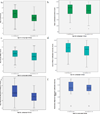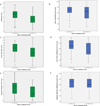The Autism Diagnostic Observation Schedule, Toddler Module: Standardized Severity Scores
- PMID: 25832801
- PMCID: PMC4898775
- DOI: 10.1007/s10803-015-2432-7
The Autism Diagnostic Observation Schedule, Toddler Module: Standardized Severity Scores
Abstract
Standardized calibrated severity scores (CSS) have been created for Autism Diagnostic Observation Schedule, 2nd edition (ADOS-2) Modules 1-4 as a metric of the relative severity of autism-specific behaviors. Total and domain CSS were created for the Toddler Module to facilitate comparison to other modules. Analyses included 388 children with ASD age 12-30 months and were replicated on 435 repeated assessments from 127 children with ASD. Compared to raw scores, associations between total and domain CSS and participant characteristics were reduced in the original sample. Verbal IQ effects on Social Affect-CSS were not reduced in the replication sample. Toddler Module CSS increases comparability of ADOS-2 scores across modules and allows studies of symptom trajectories to extend to earlier ages.
Figures



Similar articles
-
The autism diagnostic observation schedule, module 4: revised algorithm and standardized severity scores.J Autism Dev Disord. 2014 Aug;44(8):1996-2012. doi: 10.1007/s10803-014-2080-3. J Autism Dev Disord. 2014. PMID: 24590409 Free PMC article.
-
Replication of Standardized ADOS Domain Scores in the Simons Simplex Collection.Autism Res. 2015 Oct;8(5):583-92. doi: 10.1002/aur.1474. Epub 2015 Feb 24. Autism Res. 2015. PMID: 25712123 Free PMC article.
-
Standardizing ADOS scores for a measure of severity in autism spectrum disorders.J Autism Dev Disord. 2009 May;39(5):693-705. doi: 10.1007/s10803-008-0674-3. Epub 2008 Dec 12. J Autism Dev Disord. 2009. PMID: 19082876 Free PMC article.
-
Replication study of ADOS-2 Toddler Module cut-off scores for autism spectrum disorder classification.Autism Res. 2021 Jun;14(6):1284-1295. doi: 10.1002/aur.2496. Epub 2021 Mar 8. Autism Res. 2021. PMID: 33683018
-
Brief Report: Examining Test-Retest Reliability of the Autism Diagnostic Observation Schedule (ADOS-2) Calibrated Severity Scores (CSS).J Autism Dev Disord. 2022 Mar;52(3):1388-1394. doi: 10.1007/s10803-021-04952-7. Epub 2021 Apr 7. J Autism Dev Disord. 2022. PMID: 33826039
Cited by
-
Evaluation of Chromosome Microarray Analysis in a Large Cohort of Females with Autism Spectrum Disorders: A Single Center Italian Study.J Pers Med. 2020 Oct 9;10(4):160. doi: 10.3390/jpm10040160. J Pers Med. 2020. PMID: 33050239 Free PMC article.
-
Screening and Prediction of Autism in Toddlers Using SORF in Videos of Brief Family Interactions.J Autism Dev Disord. 2024 Oct 7. doi: 10.1007/s10803-024-06575-0. Online ahead of print. J Autism Dev Disord. 2024. PMID: 39373881
-
Predicting Language in Children with ASD Using Spontaneous Language Samples and Standardized Measures.J Autism Dev Disord. 2023 Oct;53(10):3916-3931. doi: 10.1007/s10803-022-05691-z. Epub 2022 Aug 5. J Autism Dev Disord. 2023. PMID: 35930209
-
Sociodemographic, clinical characteristics, and service utilization of young children diagnosed with autism spectrum disorder at a research center in Saudi Arabia: The road to autism spectrum disorder diagnosis.Saudi Med J. 2021 Aug;42(8):878-885. doi: 10.15537/smj.2021.42.8.20210297. Saudi Med J. 2021. PMID: 34344812 Free PMC article.
-
Valence and Intensity of Emotional Expression in Autistic and Non-Autistic Toddlers.J Autism Dev Disord. 2025 Mar;55(3):832-842. doi: 10.1007/s10803-024-06268-8. Epub 2024 Feb 3. J Autism Dev Disord. 2025. PMID: 38315319 Free PMC article.
References
-
- American Psychiatric Association. Diagnostic and Statistical Manual of Mental Disorders. 5th. Arlington, VA: American Psychiatric Publishing; 2013.
-
- Bishop SL, Richler J, Lord C. The structure of autism symptoms as measured by the autism diagnostic observation schedule. Child Neuropsychology: A Journal on Normal and Abnormal Development in Childhood and Adolescence. 2006;12(4–5):247–267. - PubMed
-
- Bryson SE, Zwaigenbaum L, Brian J, Roberts W, Szatmari P, Rombough V, McDermott C. A prospective case series of high-risk infants who developed autism. Journal of Autism and Developmental Disorders. 2007;37(1):12–24. - PubMed
Publication types
MeSH terms
Grants and funding
LinkOut - more resources
Full Text Sources
Other Literature Sources

